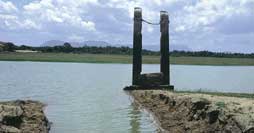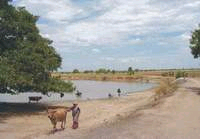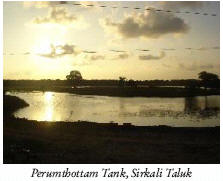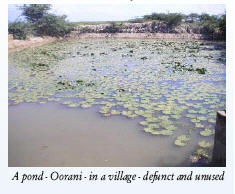 |
Traditional Systems of harvesting rainwater
Every village in Tamil Nadu had three water bodies: one for irrigation,
one for cattle and an Oorani (pond) for drinking water. All three are
rain-fed. Many villages have survived centuries because of these catchment
bodies.
| The traditional systems are a well recognised fact,
as this has been given as an example in the - XI-five-year-plan
(Rural Drinking Water and Sanitation in the Eleventh Plan period –
Excerpts). It says "For the people of Tamil Nadu
the traditional Ooranis or ponds have truly proved to be a blessing.
The Ooranis were developed as the main supply systems in Tamil Nadu
centuries back. These earthen bunded ponds wereconstructed by the
collective efforts of the people over the ages and have been
designed hydrologically to have adequate and assured inflow of
surface runoffs. Almost all Ooranis are well connected with
irrigation tanks called Kanmoi. In recent years however the
Ooranis were
neglected and dilapidated due to implementation of new water
supply facilities like handpumps, deep borewell and Combined Water
Supply Schemes (CWSS)."
- XI-five-year-plan (Rural Drinking Water and Sanitation in the
Eleventh Plan period – Excerpts)
NGOs in Tamil Nadu have done some very good work in reviving
these traditional water tanks.
(references/websites) |
| The Lifelines of Tamil Nadu
ERI
Approximately one-third of the irrigated area of Tamil Nadu is watered by eris
(tanks). Eris have played several important roles in maintaining ecological
harmony as flood -control
systems, preventing soil erosion and wastage of runoff during periods of heavy
rainfall, and recharging the groundwater in the surrounding areas. The presence
of eris provided an appropriate micro-climate for the local areas. Without eris,
paddy cultivation would have been impossible. -control
systems, preventing soil erosion and wastage of runoff during periods of heavy
rainfall, and recharging the groundwater in the surrounding areas. The presence
of eris provided an appropriate micro-climate for the local areas. Without eris,
paddy cultivation would have been impossible.
Till the British arrived, local communities maintained eris. Historical data
from Chengalpattu district, for instance, indicates that in the 18th century
about 4-5 per cent of the gross produce of each village was allocated to
maintain eris and other irrigation structures. Assignments of revenue-free
lands, called manyams, were made to support village functionaries who undertook
to maintain and manage eris. These allocations ensured eri upkeep through
regular desilting and maintenance of sluices, inlets and irrigation channels.
The early British rule saw disastrous experiments with the land tenure system in
quest for larger land revenues. The enormous expropriation of village resources
by the state led to the disintegration of the traditional society, its economy
and polity. Allocations for maintenance of eris could no longer be supported by
the village communities, and these extraordinary water harvesting systems began
to decline.
taken from rainwaterharvesting.org
http://www.rainwaterharvesting.org/Rural/Traditional3.htm#eri
Kanmois
Kanmois
are traditional tanks with earthen bunds constructed many centuries
ago. They are large surface water stores that collected and stored
surface water run-offs. They largely supported and were used for
agricultural purposes as well as for drinking water.
taken from rainwaterharvesting.org
KORAMBUS
Korambu is a temporary dam stretching across the mouth of channels,
made of brushwood, mud and grass. It is constructed by horizontally
fixing a strong wooden beam touching either banks of the canal. A
series of vertical wooden beams of appropriate height is erected with
their lower ends resting firmly on the ground and the other ends tied
to the horizontal beam. Closely knitted or matted coconut thatch is
tied to this frame. A coat of mud is applied to the matted frame. A
layer of grass is also applied carefully which prevents dissolution of
the applied mud. Korambu is constructed to raise the water level in the
canal and to divert the water into field channels. It is so built that
excess water flows over it and only the required amount of water flows
into the diversion channels. The height of the Korambu is so adjusted
that the fields lying on the upstream are not submerged. Water is
allowed to flow from one field to another until all the field are
irrigated. They are built twice a year especially before the onset of
the monsoon season in order to supply water during winter and summer
season. In Kasargod and Thrissur districts of Kerala, Korambu is known
as chira.
taken from rainwaterharvesting.org
http://www.rainwaterharvesting.org/Rural/Traditional3.htm#kora

OORANIS
Ooranis are small ponds that have collected rainwater from rains
and from surrounding catchment areas. These Ooranis traditionally
were used for various needs of drinking, washing, bathing needs of
the villages around it.
Oorani is a Tamil word meaning village pond. It
is an institution as old as Tamil society. Poet Thiruvalluvar
referred to them 2000 years ago. Ooranis were usually endowed by
ruling or merchant princes. Beneficiaries were involved in
excavation and maintenance. They developed a sense of ownership.
After Independence the government departments took over every aspect
of village management and Ooranis fell to neglect.
taken from rainwaterharvesting.org
http://www.rainwaterharvesting.org/Rural/Traditional.htm#oora
read more on this :
Dhan foundation site
MSSRF site
 |
The concept
is so interesting that it has inspired the government to
launch a scheme called "nammaku namme thittam" (meaning we are
our own support) which is based on the Kudimaramathu practice
of the ancient times |
|
| .

|
 |
| TRADITIONAL PRACTICES & MODERN ROOFTOP WATER HARVESTING
TECHNIQUES
DYING WISDOM - A CITIZENS REPORT ON TRADITIONAL WATER HARVESTING SYSTEMS
Author : Anil Agarwal and Sunita Narain
Date : 01/12/1997
Publication : TREE WORLD
Water is an invaluable gift of nature essential to sustain life in the planet.
History records that civilizations flourished around perennial sources of water
and mass exodus of people happened from places where water became scarce for
human and animal consumption. Water harvesting has been practised by the
traditional communities to conserve rainwater for meeting the future needs when
rainfall becomes scanty. However, the systems adopted varied depending upon the
source and the facilities available in different locations.
Khadin - A sound traditional method of runoff farming
in Indian desert
Author : A.S. Kolarkar
Date : 10/12/1990
The term 'rainwater harvesting' is relatively new, first used by Geddes (1963).
Similarly the term "runoff farming" is also a new term and used more and more
these days in agriculture, particularly in rainfed agriculture to improve soil
moisture conditions to support crop growth. However, it is very interesting to
note that in the deep desert of 'Thar' in Jalsalmer district of Rajasthan, where
the conventional rainfed agriculture is hazardous, the philosophy of rain water
harvesting and runoff farming had been put to practice as early as in 15th
century. This method ensures at least...
Micro alternative to dams
Author : Tarun Bose
Date : 13/09/1995
Publication : THE ECONOMIC TIMES
A MICRO watershed approach is emerging as a viable alternative to the large dams
in Palamau, Bihar for rainwater harvesting. About 132 small rain water
harvesting reservoirs built in the district would irrigate 3500 acres of land.
The rainfall in the district ranges from an average of 1088 mm in the level
north to 1820 mm in the hilly south. The surface run off from the monsoon is
important for paddy and rabi crops.
THE INDISSOLUBLE CONNECTION
Author : DEEP NARAYAN PANDEY
Date : 15/08/2001
Publication : DOWN TO EARTH
TRADITIONAL water harvesting systems, such as tanks locally called "talabs", are
an integral part of every village in Madhya Pradesh. Varying in size from less
than an acre to a hundred hectares or more, talabs were built by rulers and
communities several hundred years ago using the traditional knowledge of village
communities. These tanks have served the rural society by meeting the daily
water requirements of the people and their livestock and also helping in ground
water recharge. Many of these tanks make an excellent network of capturing the
rainwater. Water that overflows from ...
RALEGAON SIDDI
Drought-proofing
Author : Gail Omvedt
Date : 17/06/2000
Publication : THE HINDU (MADRAS)
IN THE midst of India's most fearsome drought in a decade, people are looking
for genuine ways of "droughtproofing." Often mentioned as an example is Ralegan
Siddhi, a village in Ahmednagar district of Maharashtra. Rainwater harvesting
was one of many campaigns taken up after Anna Hazare, an army driver who was
apparently miraculously saved after his entire platoon had been killed in a
battle, returned home to dedicate himself to social work. In Maharashtra,
Ralegan Siddhi's watershed development, along with programmes of anti-alcoholism
and an all-women panchayat, was taken as...
PANI PANCHAYAT
Pani panchayat creates reverse migration
Author : USHA RAI
Date : 12/01/2001
Publication : GRASSROOTS
MAHUR village in Purandhar block of Pune district is like a green oasis in the
parched, drought-prone district of Maharashtra. Standing on a small hillock for
miles around green fields could be seen. At the base of the hillock is a minor
irrigation tank into which the rainwater is harvested. This almost perennially
full water body is the lifeline of Mahur village and its principle of equity in
water distribution its sustenance. In a country where rural people failing to
get a return from their agricultural lands are migrating to the big cities in
search of jobs, in the 30 odd...
The simplest rainwater harvester
Author : Shree Padre.
A very simple method of rain water harvesting (RWH) is practiced in heavy
rainfall areas of Kerala and Karnataka. It uses a saree to collect rainwater and
meets the day-to-day drinking water needs of residents. Catching water with a
saree is a fore-runner of roofwater harvesting wherein jobs of all the three
parts of the system, namely, catchment, transport and flitration of rain is
executed by a single cloth piece. The picture above depicts the system in use at
Vamdse village in Kundapura Taluk of Udupi District, Karnataka. The Grama
Panchayat (GP) here has dug two borewells for the colony...
Original Url: http://www.indiatogether.org/photo/2004/env-rwhsaree.htm
|
|
 |


 -control
systems, preventing soil erosion and wastage of runoff during periods of heavy
rainfall, and recharging the groundwater in the surrounding areas. The presence
of eris provided an appropriate micro-climate for the local areas. Without eris,
paddy cultivation would have been impossible.
-control
systems, preventing soil erosion and wastage of runoff during periods of heavy
rainfall, and recharging the groundwater in the surrounding areas. The presence
of eris provided an appropriate micro-climate for the local areas. Without eris,
paddy cultivation would have been impossible.



